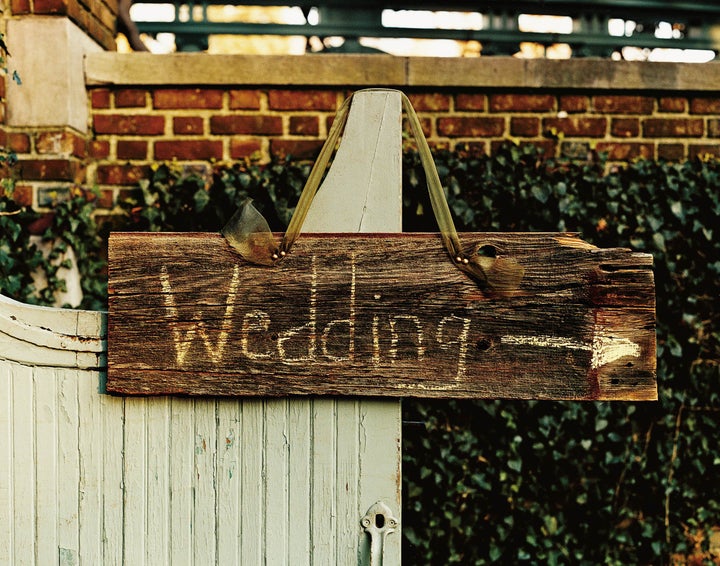For BRIDES, by Katie James.

Here’s how to plan the wedding of your dreams — without going into debt.
Your wedding will likely be the biggest party you’ve ever hosted — and the priciest. The average U.S. wedding costs $26,522 for 135 guests, according to the 2016 Brides American Wedding Study. Nearly half of couples cover the entire expense themselves, while an additional 25 percent pay for at least part of it. But here’s the kicker: One in three couples goes over budget! Make sure you’re not one of them by setting a realistic wedding budget — before you start fantasizing about venues in Italy, booking expensive vendors, or trying on designer dresses.
To make a wedding budget, you’ll need to tally up your savings, maintain a detailed spreadsheet so you don’t go over during the planning process, prepare for unexpected costs, as well as make meaningful cuts if you do exceed your total budget. It’s hard work, we know, but putting in the time and energy now ensures you’ll live happily ever after (wedding-debt free).
Step 1: Count Your Cash
How much you have to spend on the wedding is directly proportional to three sources of money: you and your fiancé’s individual savings; the amount you can set aside from your current income; plus any contributions from parents or loved ones. Here’s how to approach each:
Your savings: This isn’t as simple as checking your bank account. Ideally, you and your partner each have three months of living expenses set aside in case of a job loss or health setback (separate from retirement funds). Subtract that in-case-of-emergency amount from your total balance in the bank, and that’s how much you could put toward wedding costs.
Your monthly income: After you’ve made payments for existing debts, like student loans, set aside up to 10 percent of your earnings each month. “Establish direct deposits into a separate account for wedding expenses so it isn’t just leftovers that get saved,” says Erin Lowry, a personal-finance expert and the author of Broke Millennial: Stop Scraping By and Get Your Financial Life Together.
Any contributions from your parents: “Never assume your parents or other loved ones are willing and able to help cover the cost of a wedding,” says Lowry. “But it certainly doesn’t hurt to ask.”
See More: The 50 Most Beautiful Wedding Cakes Ever
Step 2: Track Your Spending
Create a spreadsheet with three expense columns: Estimated, Modified, and Actual. Amounts under Estimated will be driven by research of costs in your area (check sites like Weddingwire and Thumbtack to find local averages for venues and vendors), proposals from the vendors you choose will go in Modified, and the final amount you pay them will go in Actual.
Adjust your estimates after calling in vendors’ costs. Start with the venue because it’s the biggest piece of the wedding pie and a major factor in determining guest count. When vendors give you estimates, verify if tax is included. If not, do the math yourself with state and local tax rates to adjust the proposal.
Add a column for the estimated tip. Write “included” if gratuity is factored into the vendor’s price. (For example, caterers automatically tack on 15 to 20 percent of the total, which you pay in advance.)
Add a line item called Extras that equals 15 percent of your total budget to cushion for things you’ll likely forget (invitation postage, parking valets) or won’t anticipate in advance (corkage and plating fees). Never spend this money up front; you’ll need it throughout the planning process as incidentals arise. Trust.
Step 3: Prepare for Surprises
Before you sign on the dotted line of vendor contracts or start buying gift bag items, read the fine print, because expenses that seem small early on could add up quickly. If the total of the line item isn’t in your overall budget, cut it!
Vendor Transportation: Hiring an out-of-town band or photographer? You might need to pay for a rental van or plane tickets. Double-check the contract to see what exactly is covered.
Set-Up And Breakdown Fees: Cleanup isn’t always included, and you may have to pay overtime rates depending on what time your reception ends.
Custom Cocktails: Signature drinks and spirits can add $3,500 to a 200-person wedding, says Calder Clark, a top wedding planner in Charleston, South Carolina.
Digital Access: Some photographers charge as much as $1,200 to view and share your photos online.
Envelope Stuffing: Some stationers charge as much as $7 per invite. To save, call your bridesmaids over, drink some wine, and DIY instead.
Planners: A full-service event designer can charge as much as $25,000 or even 20 percent of the total budget for a Kardashian-scale affair, but a day-of coordinator costs an average of $1,500. Before you enlist a pro, know what you have to spend and factor in that rate.
See the rest of The Crazy Easy Steps to Creating Your Wedding Budget on Brides.com
More From BRIDES:
